Porto Alegre
Porto Alegre (UK: /ˌpɔːrtuː əˈlɛɡreɪ/, US: /- ɑːˈleɪɡri, ˌpɔːrtoʊ əˈlɛɡrə/,[3][4] Brazilian Portuguese: [ˈpoɾtu aˈlɛɡɾi] (![]() listen);[lower-alpha 1] lit. '"Joyful Harbor"') is the capital and largest city of the Brazilian state of Rio Grande do Sul. Its population of 1,488,252 inhabitants (2020) makes it the twelfth most populous city in the country and the center of Brazil's fifth largest metropolitan area, with 4,405,760 inhabitants (2010). The city is the southernmost capital city of a Brazilian state.[5]
listen);[lower-alpha 1] lit. '"Joyful Harbor"') is the capital and largest city of the Brazilian state of Rio Grande do Sul. Its population of 1,488,252 inhabitants (2020) makes it the twelfth most populous city in the country and the center of Brazil's fifth largest metropolitan area, with 4,405,760 inhabitants (2010). The city is the southernmost capital city of a Brazilian state.[5]
Porto Alegre | |
|---|---|
| Município de Porto Alegre Municipality of Porto Alegre | |
From top to bottom and left to right: downtown view at night; Statue of the Laçador; Mário Quintana House of Culture; Monument to the Azoreans in front of the Administrative Center of the State; Monument to the Expeditionary in Farroupilha Park; Gasometer Plant; panorama of the city from the Lake Guaíba. | |
 Flag  Seal | |
| Motto(s): Leal e Valorosa Cidade de Porto Alegre Loyal and Valiant city of Porto Alegre | |
 | |
 Porto Alegre Location in Brazil | |
| Coordinates: 30°01′59″S 51°13′48″W | |
| Country | |
| Region | South |
| State | |
| Mesoregion | Metropolitan Porto Alegre |
| Microregion | Microregion of Porto Alegre |
| Founded | 26 March 1772 |
| Government | |
| • Mayor | Sebastião Melo (MDB) |
| Area | |
| • Municipality | 496.827 km2 (191.826 sq mi) |
| Elevation | 10 m (30 ft) |
| Population (2020)[1] | |
| • Municipality | 1,488,252 (12th) |
| • Density | 2,837.5/km2 (7,349/sq mi) |
| • Metro | 4,405,769 (4th) |
| Demonym | Porto-alegrenses |
| Time zone | UTC-3 (UTC−3) |
| Postal Code | 90000-000 |
| Area code | +55 51 |
| HDI (2010) | 0.805 – very high[2] |
| Website | www |
Porto Alegre was founded in 1769 by Manuel Jorge Gomes de Sepúlveda, who used the pseudonym José Marcelino de Figueiredo to hide his identity; but the official date is 1772 with the act signed by immigrants from the Azores, Portugal.
The city lies on the eastern bank of the Guaíba Lake, where five rivers converge to form the Lagoa dos Patos, a giant freshwater lagoon navigable by even the largest of ships. This five-river junction has become an important alluvial port as well as a chief industrial and commercial center of Brazil.
In recent years, Porto Alegre hosted the World Social Forum, an initiative of several non-government organizations. The city became famous for being the first city that implemented participatory budgeting.[6] The 9th Assembly of the World Council of Churches was held in Porto Alegre in 2006. Since 2000, Porto Alegre also hosts one of the world's largest free software events, called FISL.
The city was one of the host cities of the 2014 FIFA World Cup, having previously been a venue for the 1950 FIFA World Cup.
In the middle of 2010s, Porto Alegre had a growing wave of violence,[7] being ranked as 39th among the world's 50 most violent cities in 2017.[8] Nevertheless, the number of violent crimes has been dropping steadily since 2018.[9][10]
History

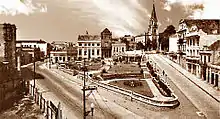
The official date of the foundation of the city of Porto Alegre is 26 March 1772 by Manuel Sepúlveda, when Freguesia de São Francisco do Porto dos Casais was created and changed a year later to Nossa Senhora da Madre de Deus de Porto Alegre. However, the village started in 1752, when 60 Azorean couples were brought over by the Treaty of Madrid in order to set up Missions at the Northeast Region of Rio Grande do Sul that was handed over to the Portuguese Crown in exchange for the Sacramento Colony located on the margin of the Plata River. Land demarcation took a long time and the Azoreans settled permanently at Porto de Viamão, which was the first name by which Porto Alegre went by.[11]
On 24 July 1773, Porto Alegre became the capital city of the province, when the administration of Manuel Sepúlveda, who used the fictitious name or pseudonym José Marcelino de Figueiredo, to hide their identity, officially started. In 1824, immigrants from all over the world started arriving, especially German, Italian, Spanish, Polish, Jewish, and Lebanese.[12]

The capital city of Rio Grande do Sul is also the capital city of the Pampas region, the name given to the region of fauna and flora typical of the vast plains that dominate the landscape of the southern tip of Brazil, part of Argentina and Uruguay. This is where the Gaúcho comes from, the historical figure of a brave warrior that fought legendary battles and wars in the quest to conquer the borders of the Kingdoms of Portugal and Spain in the 16th century.[11]
There were many wars, but it was the nineteenth century that marked its people, after they fought a long war for their independence from the Brazilian Empire. The Farrapos War started with the confrontation in Porto Alegre, near the Azenha bridge on 20 September 1835. This conflict etched in the pages of history the myth of the gaucho that is still praised in songs and celebrated in annual pageants and honored as names of streets and parks.[11]
When the Farrapos War ended, the city continued to develop and underwent strong urban restructuring during the last decades of the 18th century, driven by the accelerated growth of port-related activities and shipyards. Its development continued over time and the city kept abreast with cultural, political and social events that were taking place within Brazil. Porto Alegre is the birthplace of great writers, intellectuals, artists, politicians, and episodes that marked the history of Brazil.[11]
The city became known worldwide in 1963 through hosting the World University Games.[13] In 1985, the people of Porto Alegre joined the movement for free elections and one of the largest demonstrations took place in the city.[14]
The city

The city is on a delta resulting from the junction of five rivers, officially called Guaíba Lake (popularly mentioned as a river, too). The city dates from the mid-18th century, when immigrants from the Azores, islands in the Atlantic Ocean that are part of Portugal, settled in the area, encouraged by the Portuguese government.[15] The city was officially established in 1742.[16] Porto Alegre is one of the wealthiest cities in Latin America[17] and one of the most diverse. Its residents includes immigrants from Portugal, Russia, Germany, Italy, Spain, Ukraine and Poland. There are also significant Arab and Jewish contingents among its population.[18] The Afro-Brazilian population of the state is concentrated in the city.
Before this, Porto Alegre was the port of Viamão on the shore of Guaíba Lake. Its previous name was Porto dos Casais (Port of the Couples). and it was initially settled by Azoreans. Many families of settlers came from the city of Rio Grande in the littoral Lagunar region, to the south, a military fortress at that time. Today Rio Grande is the most important port of the State of Rio Grande do Sul. The city is also known as "Porto do Sol" (Port of the Sun) and "Cidade Sorriso" (Smile City).[19] More than 70 neighborhoods (see below) are part of the city and two-thirds of the population are concentrated in the Zona Norte (Northern Zone), where most of the economic activity, including the city center, takes place.
Porto Alegre was the seat of the World Social Forum in 2001, 2002, 2003, 2005 and 2010. As the second largest city in southern Brazil, it is an important industrial center in the area. It is also a center for gaúcho (the popular name for natives of the state) history and culture, famous for its churrasco (barbecue) and chimarrão (a strong and hot tea prepared from erva mate). Important Brazilian universities, such as Universidade Federal do Rio Grande do Sul (UFRGS), Universidade Federal de Ciências da Saúde de Porto Alegre (UFCSPA) and Pontifícia Universidade Católica do Rio Grande do Sul (PUCRS) are there. In 2000, the literacy rate was 97%.[20] The high quality of life is one of the city's main features.
Geography
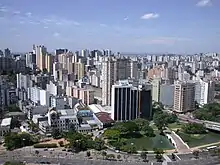
.jpg.webp)
The city of Porto Alegre is located at the northern end of the large coastal lagoon, Lagoa dos Patos in southeastern Brazil. The city lies on the east bank of the mouth of the Rio Guaiba, the estuary of which forms the enormous freshwater lagoon, Lagoa dos Patos. It additionally serves as the state capital of Brazil's southernmost state, Rio Grande do Sul.
Porto Alegre has a long coastline on the Guaíba Lake, and its topography is punctuated by 40 hills. In the lake, a vast body of water, a maze of islands facing the city creates an archipelago where a unique ecosystem gives shelter to abundant wildlife. The city area concentrates 28% of the native flora of Rio Grande do Sul, with 9,288 species.[21] Among these, there are many trees which are vestiges of the Atlantic Forest. Fauna are also diversified, especially in the islands and hills. The Portoalegrense environs include many parks, squares and wooded streets.
Climate
| Porto Alegre | ||||||||||||||||||||||||||||||||||||||||||||||||||||||||||||
|---|---|---|---|---|---|---|---|---|---|---|---|---|---|---|---|---|---|---|---|---|---|---|---|---|---|---|---|---|---|---|---|---|---|---|---|---|---|---|---|---|---|---|---|---|---|---|---|---|---|---|---|---|---|---|---|---|---|---|---|---|
| Climate chart (explanation) | ||||||||||||||||||||||||||||||||||||||||||||||||||||||||||||
| ||||||||||||||||||||||||||||||||||||||||||||||||||||||||||||
| ||||||||||||||||||||||||||||||||||||||||||||||||||||||||||||
According to the Köppen climate classification, Porto Alegre has a humid subtropical climate (Cfa) characterized by its high variability, but with well-defined seasons and evenly distributed rain throughout the year. The presence of Lake Guaíba contributes to increase the humidity of the air.[22] The city experiences the most prominent difference among seasons and between temperature extremes among all Brazilian capitals. One reason for that is the highest latitude, which also contributes for the occurrence of 14 hours of daylight in December and 10 hours in June.[23] Due to a large depletion in the ozone layer over the south of Brazil, a result of the Antarctic ozone hole,[24] the population is occasionally dangerously exposed to extremely high UV radiation.[25]
The winter is mild to cool, windy, rainy and quite changeable, which is also a feature of this time of the year. Usual winter temperatures range from 10 °C (50 °F) to 19 °C (66 °F). In the coldest days of the year the temperature may fall slightly below zero, like in 2012, when it recorded −0.7 °C (31 °F).[26] The summers are very hot, with temperatures that go up to 30 °C (86 °F), sometimes reaching 40 °C (104 °F).[27] Sometimes, summer usually has irregular rains and periods of drought.[28] Fall tends to be as changeable as winter, but is typically warmer. Spring is usually very rainy, with thunderstorms, strong winds and hailstorms.[29][30][31] The climate of Porto Alegre is very affected by El Niño phenomenon, with flooding in some neighborhoods of the city, especially in the islands in the Lake Guaiba.[32][33][34] However, a drainage system and a wall along the Historic District were built after a major flood in 1941 that devastated the city, preventing further damage.[35][36]
Snow is very rare, sometimes confused with sleet.[37] The only snowfall events in Porto Alegre were in 1879, 1910, 1984, 1994, 2000 and 2006, and few of them featured accumulation.[38] However, frost sometimes occurs in the city.[39] Occurrence of radiation fog is common, causing several delays in early flights. Unlike other large Brazilian cities much farther north, notably Brasília, São Paulo, and Rio de Janeiro who observe a pronounced summer maximum in precipitation amounts, the city of Porto Alegre experiences a prominent winter maximum in precipitation values and cloud cover, for the summer season is primarily hot and dry; though evidently high humidity levels often give a distinct mugginess to the air and negatively impacts air quality. Annually Porto Alegre receives an average-total precipitation amount of 1,425 millimetres (56.1 in). This average makes the city slightly wetter than Rio at 1,172 millimetres (46.1 in) yet, to a very small extent, drier than both São Paulo at 1,457 millimetres (57.4 in) and Brasilia at 1,557 millimetres (61.3 in).[40]
The highest recorded temperature was 42.6 °C (108.7 °F)[41] while the lowest recorded temperature was −3.0 °C (26.6 °F).[42]
| Climate data for Porto Alegre (1981–2010, extremes 1949–present) | |||||||||||||
|---|---|---|---|---|---|---|---|---|---|---|---|---|---|
| Month | Jan | Feb | Mar | Apr | May | Jun | Jul | Aug | Sep | Oct | Nov | Dec | Year |
| Record high °C (°F) | 39.2 (102.6) |
39.0 (102.2) |
38.1 (100.6) |
36.0 (96.8) |
32.7 (90.9) |
31.6 (88.9) |
32.2 (90.0) |
34.9 (94.8) |
38.0 (100.4) |
38.2 (100.8) |
39.0 (102.2) |
40.3 (104.5) |
40.3 (104.5) |
| Average high °C (°F) | 30.5 (86.9) |
30.2 (86.4) |
29.1 (84.4) |
25.9 (78.6) |
22.2 (72.0) |
19.8 (67.6) |
19.3 (66.7) |
21.3 (70.3) |
22.1 (71.8) |
25.0 (77.0) |
27.4 (81.3) |
29.5 (85.1) |
25.2 (77.4) |
| Daily mean °C (°F) | 24.7 (76.5) |
24.5 (76.1) |
23.5 (74.3) |
20.3 (68.5) |
16.9 (62.4) |
14.4 (57.9) |
13.8 (56.8) |
15.3 (59.5) |
16.7 (62.1) |
19.4 (66.9) |
21.5 (70.7) |
23.6 (74.5) |
19.6 (67.3) |
| Average low °C (°F) | 20.6 (69.1) |
20.5 (68.9) |
19.5 (67.1) |
16.5 (61.7) |
13.3 (55.9) |
10.8 (51.4) |
10.1 (50.2) |
11.1 (52.0) |
12.8 (55.0) |
15.3 (59.5) |
17.1 (62.8) |
19.0 (66.2) |
15.6 (60.1) |
| Record low °C (°F) | 10.1 (50.2) |
11.9 (53.4) |
9.6 (49.3) |
4.5 (40.1) |
2.3 (36.1) |
−1.9 (28.6) |
−1.1 (30.0) |
−1.2 (29.8) |
2.2 (36.0) |
4.9 (40.8) |
6.7 (44.1) |
10.0 (50.0) |
−1.9 (28.6) |
| Average precipitation mm (inches) | 110.1 (4.33) |
106.5 (4.19) |
92.2 (3.63) |
107.3 (4.22) |
118.8 (4.68) |
141.3 (5.56) |
141.3 (5.56) |
117.4 (4.62) |
141.5 (5.57) |
138.3 (5.44) |
110.9 (4.37) |
99.6 (3.92) |
1,425.2 (56.11) |
| Average precipitation days (≥ 1.0 mm) | 9 | 9 | 8 | 9 | 9 | 9 | 9 | 9 | 10 | 10 | 8 | 8 | 107 |
| Average relative humidity (%) | 72.9 | 74.8 | 75.3 | 77.6 | 81.0 | 82.7 | 80.7 | 77.8 | 77.0 | 75.0 | 72.1 | 70.9 | 76.5 |
| Mean monthly sunshine hours | 227.2 | 195.2 | 202.4 | 166.0 | 146.9 | 115.6 | 131.4 | 145.3 | 145.8 | 178.0 | 215.2 | 232.4 | 2,101.4 |
| Source: Instituto Nacional de Meteorologia[43][44] | |||||||||||||
Vegetation

Porto Alegre lies in a transitional area between the subtropical forest and the Southern Brazilian grasslands (pampa). A number of conservation programmes have been established to protect native trees. Many of the city's avenues have been planted with different tree species. One striking example of this is Teresópolis Avenue, where bottle trees have been planted. The city is covered in green vegetation and Lapacho and Jacaranda are the main species that can be found locally. The trees from the hills are protected. Two environmental conservation areas can be found in this city: "Delta do Jacuí" (Jacuí Delta) State Park and Lami Biological Reserve.[45]
The urban area has many parks and plazas, making Porto Alegre one of the greenest provincial capitals in Brazil. The first city squares date from the second half of the 18th century and were originally large public spaces used as food markets. The city has 39 km2 (9,600 acres) of green space, occupying 31 percent of the city's area. This is an average of 17.6 m2 per person. More than one million trees line the public streets and SMAM plants an average of 30,000 seedlings each year. The four main parks are: Parque Farroupilha, a 37-hectare (91-acre) park; Jardim Botânico (The Botanical Garden of Porto Alegre), with some 725 species of vegetation on about 43 hectares (110 acres) of land; and Parque Marinha do Brasil (The Brazilian Navy's Park), a vast park of more than 70 hectares (170 acres) which offers a wide variety of sports fields and tracks. The city's cycleway is called the Caminho dos Parques, which at over 5 km (3 miles) long links the Moinhos do Vento, Farroupilha and Guaíba shore parks.[46]
The Lami José Lutzenberger Biological Reserve was established in 1975 in the Lami neighborhood of Porto Alegre, named after the local agronomist and environmentalist José Lutzenberger. It was the first municipal reserve in Brazil. The reserve covers 179 hectares (440 acres). It reopened in April 2002 after being closed for more than ten years to allow its ecosystems to recover.[47] The reserve conserves nature and supports research and environmental education.[48]
Water

Sewer service is available to 87.7 percent of the city, and 100 percent of the population is serviced by treated water.[49] While in most Brazilian cities the water is supplied by large state companies, in Porto Alegre the Municipal Department of Water and Sanitation Services, (DMAE) is the provider. It is the largest municipal water supplier in the country and enjoys operational autonomy and financial independence. As a separate entity from the municipal government it can make its own decisions on how to invest revenues it has collected, and such decisions are not directly subject to interference from the municipality. It receives no subsidies and makes no payments to the municipality itself. As a municipal undertaking, DMAE enjoys tax-exempt status, which allows it to keep water prices lower.[50]
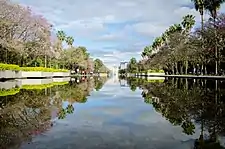

In 2010, the Inter-American Development Bank (IDB) approved a US$83.2 million to support the Integrated Socioenvironmental Program of Porto Alegre. The program will be carried out by the Municipal Department of Management and Strategic Support and will focus on improving water quality in Guaíba Lake and the Cavalhada River, developing urban infrastructure to reduce flood risk along the Cavalhada River, improving the environmental management in the Municipality of Porto Alegre, and promoting efficient municipal water, sanitation and storm drainage services. This program will improve the quality of life of the population of Porto Alegre by restoring water quality along the west side of Lake Guaíba and directly benefitting more than 700,000 residents through expanded public sanitation services and urban environmental improvement.[51]
The Jacuí estuary contains the Jacuí Delta State Park, which in turn contains the Banhados do Delta Biological Reserve, a fully protected area which covers the islands of Pólvora and Pombas.[52]
Air quality
Motor vehicles are responsible for the main atmospheric pollutant emissions. The city has the second worst air quality in Brazil, after only São Paulo.[53] The use of new buses along dedicated busways has decreased pollutants as there is less idling time. SMAM (the Municipal Council of the Environment) has encouraged the use of the cleanest fuels and has played a role in monitoring pollution levels.
A partnership between SMAM, the Federal University of Rio Grande do Sul, the State Environmental Protection Foundation (FEPAM) and Petrobrás has created a network of five air monitoring stations in Porto Alegre. By utilizing a Petrobrás product called city diesel, sulphur levels in the air have dropped from 1.2 percent in 1989 to 0.5 percent. Hybrid buses which run on both diesel and electricity are also being considered for the future. Because Porto Alegre has a ready supply of natural gas, the city's taxi fleet is gradually being converted to it from gasoline.[54]
Demographics
.jpg.webp)
Ethnic groups
According to the 2010 IBGE Census, there were 1,365,039 people residing in the city of Porto Alegre.[55] The census revealed the following numbers: 1,116,659 White people (79.2%), 143,890 Black people (10.2%), 141,411 Pardo (Multiracial) people (10%), 4,062 Asian people (0.3%), 3,308 Amerindian people (0.2%).[56] In 2010, the city of Porto Alegre was the 10th most populous city in Brazil.[57] In 2010, the city had 269,519 opposite-sex couples and 1,401 same-sex couples. The population of Porto Alegre was 53.6% female and 46.4% male.[56]
Porto Alegre is mostly composed of Brazilians of European descent. Its colonization started in the mid-18th century, mostly with the arrival of Portuguese colonists from the Azores Islands. From 1748 to 1756, 2,300 Azoreans were sent to the region by the King of Portugal to protect Southern Brazil from neighboring invaders.[58] These colonists, mostly composed of married couples, established the city of Porto dos Casais (literally translated "harbor of the couples"), nowadays Porto Alegre. In 1775, 55% of Rio Grande do Sul's population was of Azorean Portuguese origin.[59] Porto Alegre was composed mainly of Azoreans and their African slaves until the first half of the 19th century.

Religion in Porto Alegre (2010)
The first non-Portuguese people to settle Rio Grande do Sul were German immigrants. In 1824, the first immigrants from Germany arrived in Porto Alegre, but they were sent to what is now the city of São Leopoldo (28 km (17 mi) away). From 1824 to 1914, 50,000 Germans arrived in Rio Grande do Sul.[60] Most of these colonists had rural communities in the countryside of the State as their first destination. The large rural exodus in Brazil in the early 20th century brought many German-descendants to Porto Alegre and, nowadays, they compose a large percentage of the population.[61]
The second largest group of immigrants who arrived in Porto Alegre were the Italians. They started immigrating to Brazil in 1875, mainly from the Northern Italian Veneto region.[62] As the Germans, Italians were also first sent to rural communities, mainly in the Serra Gaúcha region. After some decades, many of them started to migrate to other parts of Rio Grande do Sul, including Porto Alegre. Minority communities of immigrants, such as Central Europeans from Poland[63] and Eastern Europeans from Ukraine and Jews; Arabs from Palestine, Lebanon and Syria; Asians from Japan; as well as Spaniards arriving after the Civil War also made Porto Alegre their home.[64][65] According to an autosomal DNA genetic study from 2011, the ancestral composition of the population of Porto Alegre is: 77.70% European, 12.70% African and 9.60% Native American.[66]
Population growth

- Changing demographics of the city of Porto Alegre

Source: Planet Barsa Ltda.[67]
Religion
According to the 2010 population census, the population of Porto Alegre is made up of Roman Catholics (63.85%); Protestants or evangelicals (11.65%); spiritists (7.03%); Umbanda and Candomblé (3.35%); the unreligious (10.38%) and people of other religions (3.64%).[68]
The Church of Jesus Christ of Latter-day Saints has a temple in Porto Alegre.[69]
Politics, government and citizenship

The executive branch is headed by the mayor of the municipality, which includes departments and other public administration bodies directly and indirectly. The legislature is represented by the City Council.
It hosted the first three editions of the World Social Forum in 2001, 2002 and 2003. The third edition attracted 20,763 delegates from 130 countries, with a total audience of 100,000 people from all parts of the world.
Participatory budgeting
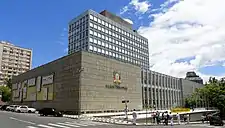

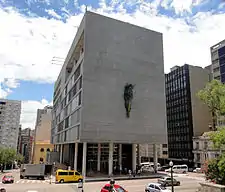
A feature of public administration in Porto Alegre is the adoption of a system of popular participation in the definition of public investment, called the Participatory Budget. The first full participatory budgeting process was developed in the city starting in 1989. Participatory budgeting in its most meaningful form took place in the city from 1991 to 2004.[70] Participatory budgeting was part of a number of innovative reform programs to overcome severe inequality in living standards amongst city residents. One third of the city's residents lived in isolated slums at the city outskirts, lacking access to public amenities (water, sanitation, health care facilities, and schools).[71]
Participatory budgeting in Porto Alegre has occurred annually, starting with a series of neighborhood, regional, and citywide assemblies, where residents and elected budget delegates identify spending priorities and vote on which priorities to implement. Porto Alegre spent about 200 million dollars per year on construction and services, This money is subject to participatory budgeting, unlike the annual spending on fixed expenses such as debt service and pensions, which is not subject to public participation. Around fifty thousand residents of Porto Alegre took part at the peak of the participatory budgeting process (compared to 1.5 million city inhabitants), with the number of participants having grown year on year since 1989. Participants are from diverse economic and political backgrounds.[72][73] Although participatory budgeting appears to continue in the city today, two prominent scholars on the process have stated that "after the defeat of the Workers' Party in late 2004, a politically conservative coalition maintained the surface features of PB while returning the actual functioning of the administration to more traditional modes of favor-trading and the favoring of local elites."[70]
The participatory budgeting cycle starts in January and runs throughout the year in many assemblies in each of the city's 16 districts, dealing with many areas of interest to urban life. The meetings elect delegates to represent specific neighborhoods. The mayor and staff attend, in order to respond to citizens' concerns. In the following months, delegates meet to review technical project criteria and district needs.[72]

City department staff may participate according to their area of expertise. At a second regional plenary, regional delegates prioritize the district's demands and elect 42 councillors representing all districts and thematic areas to serve on the Municipal Council of the Budget. The main function of the Municipal Council of the Budget is to reconcile the demands of each district with available resources, and to propose and approve an overall municipal budget. The resulting budget is binding, though the city council can suggest, but not require, changes. Only the Mayor may veto the budget, or remand it back to the Municipal Council of the Budget (this has never happened).[72]
A World Bank paper suggests that participatory budgeting has led to direct improvements in facilities in Porto Alegre. For example, sewer and water connections increased from 75% of households in 1988 to 98% in 1997. The number of schools quadrupled since 1986.[71] According to Fedozzi and Costa, this system has been recognized as a successful experience of interaction between people and the official administrative spheres in public administration and, as such, has gained a broad impact on the political scene nationally and internationally, being interpreted as a strategy for the establishment of an active citizenship in Brazil. The distribution of investment resources planning that follows a part of the statement of priorities for regional or thematic meetings, culminating with the approval of an investment plan that works and activities program broken down by investment sector, by region and around the city. Also according to Fedozzi, this favors:[74][75]
The high number of participants, after more than a decade, suggests that participatory budgeting encourages increasing citizen involvement, according to the paper. Also, Porto Alegre's health and education budget increased from 13% (1985) to almost 40% (1996), and the share of the participatory budget in the total budget increased from 17% (1992) to 21% (1999).[71]
Despite being the pioneering experiment of participatory budgeting, Porto Alegre like many other examples does not have guaranteed sustainability. The positive impact has dwindled since 2004 due to funding changes and decreasing government commitment. Participatory budgeting has been suspended in Porto Alegre since 2017 [76]
Economy

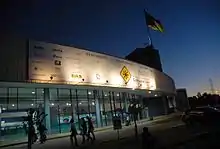
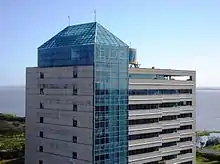
Located at the junction of five rivers, it has become an important alluvial port as well as one of the chief industrial and commercial centers in Brazil. Products of the rich agricultural and pastoral hinterland, such as soybeans, leather, canned beef, and rice, are exported from Porto Alegre to destinations as far away as Africa and Japan.[77]
Among the main businesses located in Porto Alegre are Gerdau, Petroleo Ipiranga, Zaffari and RBS. Since 2000, General Motors (GM) is operating in Gravataí, located in the Metropolitan Region. Also in this Region but in Triunfo, there is a Petrochemical Pool,[78] and in Eldorado do Sul Dell Computers has established a plant. In the health sector, the three hospitals: Hospital Moinhos de Vento, which is a private, JCAH-accredited hospital, Santa Casa de Misericordia Hospital and Clinicas Hospital, public, are considered among the best in Latin America. The latter are university-affiliated, referral hospitals for the South of Brazil. Commerce is a very important economic activity, with many malls (like Praia de Belas Shopping, Shopping Iguatemi and the smaller though posh Shopping Moinhos). The Metropolitan Region of Porto Alegre, directed to the production of shoes (around Novo Hamburgo) and to petrochemical industries, as well as services.[79]

In the city is located the Electronics Technology Center (CEITEC), focused on the development and production of application specific integrated circuits (ASICs), today announced the opening of Latin America's first IC design center. To create state-of-the-art semiconductor products for high-volume markets that will be consumed in Latin America as well as exported to global markets. CEITEC S.A will accelerate the growth of Latin America's electronics industry by leveraging Brazil's regional influence, leadership and economic strength. The company will add 60 engineers to its ranks who will design RFID, digital media and wireless communication chips for its fabrication facility now ramping up for production. The total investment by the Brazilian government is almost US$210 million. The company is implementing a fab-lite strategy with the ability to manufacture analog/digital chips at its facility in Porto Alegre. The in-house design center with more than 100 engineers.[80]
The GDP for the city was R$30,116,002,000 (2006).[81] The per capita income for the city was R$20,900 (2006).[82]
Sustainability programs
Energy
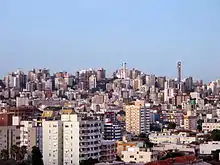
In Brazil, there are also a few coal-fired plants, fuel-oil fired plants and one nuclear facility. Increased utilization of natural gas and other sources is planned in order to reduce Brazil's overdependence on hydroelectric power. In 1999, a natural gas pipeline from Bolivia to Brazil was completed, with its terminus in Porto Alegre. Brazilian investment group Central Termoeletrica Sul (CTSul) has plans to invest US$698 million in a 650MW coal-fired power generation plant in Cachoeira do Sul, located in Rio Grande do Sul.[83]
The largest wind energy park in Brazil, which is being built east of Porto Alegre in Osório, will add 150 megawatts (MW) to the Brazilian energy matrix. The production represents 5 percent of the energy consumed in the state of Rio Grande do Sul and would be sufficient to meet two-thirds of Porto Alegre's energy demands. The Farm opened in 2008 with 75 2MW turbines and has been approved for a 300MW expansion which would make it the largest wind farm in the region. The project is part of the Alternative Energy Sources Program (Proinfa) from state-owned Eletrobrás, which will purchase the energy produced for the next 20 years.[84]
Recycling
Porto Alegre was one of the first cities in Brazil to develop a recycling program and has been acknowledged as having the best management practices in the country.[85] The city produces about 1,600 tonnes of household waste per day.[86] Since 1997, all non-recyclable waste has been disposed of in landfill sites. Infiltration into the soil is prevented by the double-walled construction of a clay layer and a high-density polythene geo-membrane, the lowering of the water table and the draining off and treatment of any effluent.[87]
Tourism and recreation

The area includes attractions such as the Piratini Palace, the seat of the state Government,[88] Porto Alegre Botanical Garden, Moinhos de Vento Park the Public Market[89] and Farroupilha Park
Nightlife

Porto Alegre is well known in Brazil for its diverse nightlife. The city's clubs, pubs, bars and restaurants provide entertainment for a wide range of tastes and budgets, going from the cheap, traditional beer-'n-bite in a corner bar to all-night raves, and nightclubs. In the "SoHo" area of Porto Alegre, there is a block full of bars, restaurants and clubs.[90]


In Cidade Baixa (translates as "Downtown") neighborhood, the historical street João Alfredo has many options. Discotheques include Dado Bier, Beco, Opinião and Nega Frida. The corner between Gal Lima e Silva Street and República Street is the center of the neighborhood's nightlife. Cavanhas, Pingüim, Copão, Cotiporã and Panorama are some of the bars. To dance MPB (Brazilian popular music), historical street João Alfredo has many options. [91]
In Calçada da Fama, Padre Chagas Street is full of more fashionable bars, like Lilliput and Dado Pub. Goethe Avenue has a concentration of bars (Tri Bar, Arsenal, Dolphin's) and dance clubs. There is also a vibrant more alternative scene with clubs such as Ocidente, Beco, Anexo B and Cucko. Rua Fernando Gomes has a concentration of pubs, cafes, bars. Avenida Osvaldo Aranha, alongside the Parque Farroupilha and near the Federal University has bars with a predominantly young and trendy clientele.[92] Moinhos de Vento is one of the richest neighborhoods in the city. Its bars and clubs are more likely to be fashionable, including upscale Pink Elephant Club, Faro and Box 21, which feature mostly house music. Along Padre Chagas Street people can find typical Irish pubs and cafes.[93] A fictionalized view of the Porto Alegre nightlife could be seen in the Érico Verissimo's novel Noite.
Education

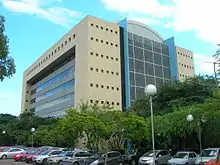
Educational institutions in the area include Universidade Federal de Ciências da Saúde de Porto Alegre (a.k.a. UFCSPA), Universidade Federal do Rio Grande do Sul (a.k.a. UFRGS), Pontifícia Universidade Católica do Rio Grande do Sul (a.k.a. PUC), Universidade do Vale do Rio dos Sinos (a.k.a. Unisinos) and Centro Universitário Ritter dos Reis.
Educational system
There are three important universities in Porto Alegre: the Federal University of Health Sciences of Porto Alegre (UFCSPA), the Federal University of Rio Grande do Sul (UFRGS) and the Pontifical Catholic University of Rio Grande do Sul (PUCRS) all of which ranked among the top universities in Brazil and Latin America. UFRGS is also one of the 3 main universities in the country for post-graduation work. The PUCRS technological park – TECNOPUC – is one of the largest scientific and technological parks in Latin America with interaction of graduate courses, research and innovation. PUCRS is also one of the best universities for air transport and pilot formation in the world. Other very important universities are the Lutheran University of Brazil - (Universidade Luterana do Brasil) - ULBRA and UNISINOS, among other university centers.[94]
Culture
Museums
.jpg.webp)
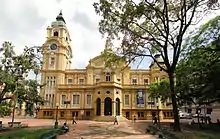
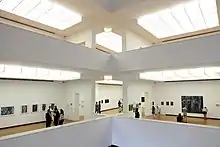

Rio Grande do Sul Museum of Art – MARGS
With an eclectic style, the building was designed by German architect Theo Wiederspahn. Originally it was the headquarters of the Fiscal Surveillance Agency of the Federal Revenue Office. Nowadays, it hosts the largest public collection of art works in Rio Grande do Sul.[95]
Júlio de Castilhos Museum
Created in 1903, this is the oldest museum in the state. Its collection comprises thousands of pieces related to the local history, from Indian relics to objects and iconography about the Ragamuffin War and the Paraguayan War, including an important section showing fine sculptures from the Jesuitic Reductions.[96]
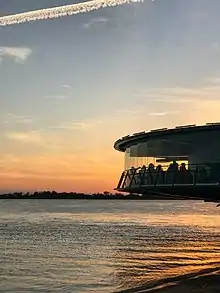
Joaquim José Felizardo Museum This is an important museum with a large collection of archaeological artifacts and photographs of Porto Alegre's old times. Its historical building, dating from 1845 to 1855, is one of the few intact relics of colonial architecture inside the modern urban environment.[97]
Rio Grande do Sul Memorial
This museum displays a huge collection of documents, maps, objects, prints and other items related to the state's history. Its building, designed by Theodor Wiederspahn, is one of the finest examples of eclectic architecture in the city.[98]
Iberê Camargo Foundation
An iconic landmark in the southern part of Porto Alegre, the Iberê Camargo Foundation houses the permanent installation of gaucho artist Iberê Camargo. It also hosts traveling exhibitions which change several times a year. The building, designed by Portuguese architect Álvaro Siza was opened in 2008 and offers views of the Guaiba river as well as downtown Porto Alegre.[99]
Luiz Carlos Prestes' Memorial
Projected by Oscar Niemeyer, the Luiz Carlos Prestes' Memorial is a recent addition to the city' cultural landscape. Besides the wall presentation of Prestes' life, a hall for cultural, social and political events is placed to the citizens of Porto Alegre.[100]
Carnival/Carnaval
The Porto Alegre Carnival began in the 18th century with the entrudo, a prank brought over by the Portuguese from the Azores, whereby people threw flour, water, and "limão de cheiro" missiles at each other. At the end of the 19th century, two important Carnival associations were born. Rivalry between the two long dominated the city's Carnival. The corso, a parade of floats down Porto Alegre's streets, was a celebration enjoyed by the more well-to-do of the city's inhabitants.[101]
One of the most important Carnival personalities is King Momo. At the beginning of Carnival, usually in February, he receives the keys to the city from the Mayor of Porto Alegre, symbolically governing the Carnival during the four days of revelry. Vincente Rao was the most popular King Momo.[102]
Cuisine
The traditional beverage is chimarrao, a South-American caffeine-rich infused drink. The Chalet of the XV de Novembro Plaza is located along the Glênio Peres Square, it is one of the most traditional bar-draught beer-restaurants in the city, where the last "lambe-lambe" photographs of the region work. "Lambe-lambes" are photographers who develop pictures outdoor using the oldest method known. In the Bavarian style, with art nouveau traits, the centenary Chalet was built up on a demountable steel structure, keeping its original chandeliers and tiles even nowadays.[103][104]
Events
.jpg.webp)
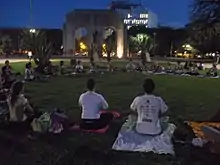
A wide range of cultural events are held in Porto Alegre. In addition to the traditional celebrations, a wide variety of activities are organized at Porto Alegre during the different seasons.
- World Social Forum: On several occasions (2001, 2002, 2003, 2005) the World Social Forum has been hosted in Porto Alegre. This event gathered more than 100,000 people from more than 100 countries each year. The main aim of these meetings is to discuss and deal with social issues.[105]
- Porto Verão Alegre: during the summer, for example, the "Porto Verão Alegre" or (Porto Summer Alegre) takes place in this city. This celebration consists of a number of performances and exhibitions. In 2005 about seventy plays could be enjoyed.[106]
- International Free Software Forum: the Fórum Internacional de Software Livre (International Free Software Forum or simply FISL) is an event sponsored by Associação Software Livre (Free Software Association), a Brazilian NGO that, among other objectives, seeks the promotion and adoption of free software.
- Farroupilha Week: this cultural celebration takes place in mid September with parades, food and musical exhibitions. The "Acampamento Farroupilha" takes place in Harmonia Park, where thousands of people set up their tents and eat typical food to commemorate the Farroupilha Revolution.[107]
- Bookfair: Held each November at Alfândega Square. In October Porto Alegre holds the greatest Book Fair in the Americas, an event that has been taking place since 1955. Each year about 2,000,000 people attend this fair.[108]
- Worldwide Pinhole Photography: this is an international event created to promote and celebrate the art of pinhole photography. The event is held each year on the last Sunday in April.[109]
- Mercosur Biennial Exhibition: is held in Porto Alegre every two years between October and December. This is an important art and cultural event that attracts a large number of people as well.[110]
- Carnival: As do other Brazilian cities, Porto Alegre holds extensive festivities during the period immediately preceding Lent. Among them, there is an Escola de Samba contest, featuring Academia de Samba Puro, Acadêmicos da Orgia, Bambas da Orgia, Estado Maior da Restinga, Fidalgos e Aristocratas, Império da Zona Norte, and Impeadores do Samba, among others.[111]
Transportation
International airport


_-_2014.jpg.webp)

Salgado Filho International Airport serves commercial flights to most major cities all over Brazil and to smaller cities in the South of the country. There are also international flights to other South American countries, Panama, and Portugal.[112]
Air Force Base
Canoas Air Force Base - ALA3, one of their most important bases of the Brazilian Air Force, is located in the nearby city of Canoas.
Port
The Port of Porto Alegre is situated in the Eastern margin of Guaíba Lake. The port lying on the eastern bank of the Guaíba lake at the point where its waters empty into the huge Lagoa dos Patos is one of Brazil's largest ports. Located near the main access roads to Porto Alegre, it is 4 km (2 mi) away from the Salgado Filho International Airport and has access to the light railway station, through the docks of Mauá and Navegantes. Its geographical position enables a permanent traffic between Porto Alegre and Buenos Aires, transporting steel-industry products and mainly agricultural produce.[113][114]
Metro
Porto Alegre has a rapid transit system operated by Trensurb, which links downtown Porto Alegre to its northern neighborhoods and to cities to the north of the metropolitan area, as Canoas, Esteio, Sapucaia do Sul, São Leopoldo and Novo Hamburgo. The line has stations at strategic spots, such as: the Public Market, the bus station, the airport and many other important and urban spots throughout Porto Alegre and the other cities the metro covers. The line is built at surface level (30 km, totally segregated) and elevated (12 km).
Trensurb is operated jointly by the federal government, the state government of Rio Grande do Sul and the city of Porto Alegre through the company Trensurb S.A. (Company of Urban Trains of Porto Alegre S.A.) and has 22 working stations, with a total extension of nearly 43 kilometres (27 mi),[115] carrying about 130,000 users a day. Building of the (sole) Line 1 of the metro started in 1980. The choice of path was made to relieve the heavy traffic of highway BR-116, which already presented serious problems with the transit at the time. The line was inaugurated on March 2, 1985, between the Central Public Market and Sapucaia do Sul. In December 1997, it was extended to Unisinos. An extension of 2.4 miles (3.9 km) São Leopoldo–Museum was added in November 2000, after two months of trial service.[116] As of 2013, an extension to Novo Hamburgo is being completed, with the first station already fully functional.[117]
A metro system inside Porto Alegre only is currently planned and it is already subject of much publicity and speculation.[118] However, no project has been approved so far and the beginning of the constructions is yet undefined.
Highways
There are two federal highways in the city, BR-290 and BR-116, both running close to its northern and northwestern border. The small number is due to the inexistence of many destinations southeast or south of Porto Alegre (considering the landmass east of Lagoa dos Patos),[119] if not for the cities of Pelotas (the third-biggest in population in the State) and Rio Grande (which hosts the State biggest port). Nonetheless, when coming from west, both highways bond in the neighbor municipality of Eldorado do Sul, running mostly jointly within the borders of Porto Alegre, only coming to separate at the very interchange to Canoas. This way, BR-116 has virtually no sole run within Porto Alegre.
BR-290 highway runs east–west across the state, linking the northeast coast of the state to the Uruguay–Argentina–Brazil border. It runs close to the northern border of the municipality. Coming from west, as it reaches the urban area of Porto Alegre, BR-290 highway becomes a high-standard 100 km (62 mi) long freeway that connects to the coast and to the BR-101 highway. The latter is an important way to get to Porto Alegre from the north of the country, by the city Osório. BR-101 connects to Curitiba, Florianópolis and northern Santa Catarina state, and has been recently upgraded to highway standards, with multiple lanes. By entering the BR-290 freeway/BR-101 system, and the other highways it connects to, it is possible to drive from Porto Alegre to as far as Rio de Janeiro or Belo Horizonte almost entirely through 4-lane (or more) highways.
The other road, BR-116, is a longitudinal highway, running northeast–south across the state, linking Porto Alegre to several satellite cities and other Brazilian capitals to the north, and Pelotas and Uruguay to the south. Within the municipality, it only touches the northwest side of the city, close to the end of Rio Gravataí (Gravataí River), sharing its entire run with BR-290, only separating when heading north onto Canoas.
A third road, BR-448, is currently under construction.[120] BR-448 is planned to connect the northeast of Porto Alegre to Sapucaia do Sul, as an alternative to BR-116, notably jam-packed on its Canoas-Novo Hamburgo stretch during traffic rush hours.
The connection between downtown Porto Alegre and the highways is made by Avenida Presidente Castelo Branco (President Castelo Branco Avenue), which is a short - 4 kilometres (2.5 mi) - avenue also bordering the northwest side of the city, Avenida dos Estados (States' Avenue), which is the access way to the Salgado Filho International Airport, and Avenida Assis Brasil (Assis Brasil Avenue), the main Avenue in the northern Porto Alegre.
Bus
.jpg.webp)

The city has a functioning transportation system, especially the autobuses. Porto Alegre has also mini-buses from and to all the main neighborhoods in the city, with sitting-only transport and the possibility to hop on and off at any point but also higher fares. Linha Turística (Tourist Line) is a bus that leaves from Usina do Gasômetro tourist terminal around six times per day. During 90 minutes, it traverses the various districts of Porto Alegre, for a modest price.[121] Exclusive bus lanes in the median of seven radial corridors that converge on the city center are used by both urban and regional lines. The bus fleet totals 1,600, with 150 minibuses. About 325 million people use the system annually.[122]
Those lines have no prefix. It is quite common to switch buses at downtown but since there is a myriad of lines there, it can be challenging to find the right terminal for the next bus. Transversal lines prefix "T" (T1, T2, ..., T11), connect different neighborhoods without going through the downtown area, which effectively eliminates the need of changing buses for the most common trips. Circular lines prefix "C" (C1, C2, C3), as the name indicates, run in a circular manner, usually connecting parts of the downtown area to the nearest neighborhoods.[123]
Mayor José Fogaça renewed his agreement with EMBARQ and the Center for Sustainable Transport Brazil (CTS-Brasil) to improve accessibility and mobility in downtown Porto Alegre. The agreement, signed on March 11, includes a new partnership with the Andean Development Corporation, a Latin American multilateral financial institution that is expected to provide $1 million in non-reimbursable technical assistance to help Porto Alegre complete the preparation phase of the "Portais da Cidade" bus rapid transit project, a groundbreaking transport system designed to reduce pollution and congestion downtown. The system will include a southern extension to accommodate activities for the 2014 FIFA World Cup. CAF's technical assistance will be administered through CTS-Brasil, which has been working to expand sustainable transport in Porto Alegre since 2005.[124]
The bus station downtown and is served by several national and international lines. It is also connected to a Trensurb station (Porto Alegre Metro) and several municipal bus lines. Northbound passengers can rely on good bus connections throughout Brazil. However, an express bus might be recommended to travel to Uruguay or Argentina to avoid several stops en route.[125]
Taxi
Porto Alegre has a total of 3,922 authorized taxicabs, with 317 taxi stops.[126] Regular taxis are colored red, whereas airport taxicabs are colored white, both with blue strips on the sides containing white lettering.
Public transportation statistics
The average amount of time people spend commuting with public transit in Porto Alegre, for example to and from work, on a weekday is 74 min. 17% of public transit riders, ride for more than 2 hours every day. The average amount of time people wait at a stop or station for public transit is 20 min, while 39% of riders wait for over 20 minutes on average every day. The average distance people usually ride in a single trip with public transit is 7.3 km, while 14% travel for over 12 km in a single direction.[127]
Sports
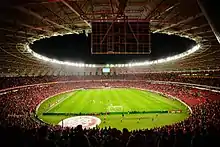

Football is a passion of the people from Porto Alegre. There is a big rivalry between two football clubs, Grêmio Foot-Ball Porto Alegrense, founded in 1903, and Sport Club Internacional, founded in 1909. Grêmio Foot-Ball Porto Alegrense and Sport Club Internacional currently play in the top league in Brazil, the Serie A. Both have successful histories, having won national and international titles, including the South American top honour, the Copa Libertadores, and the highest global trophy for football clubs, the Intercontinental Cup, now known as the Club World Cup.[128]
Porto Alegre was one of the host cities of the 2014 FIFA World Cup held in Brazil. The modernization of the Beira-Rio Stadium, home of SC Internacional and the city's 2014 FIFA World Cup venue, left the venue with a capacity for 56,000 spectators. Internacional's former home, the Estádio dos Eucaliptos, was a venue for the 1950 FIFA World Cup. Local rivals Grêmio play in their own stadium in the Humaitá district. The Arena do Grêmio stadium replaced the Estádio Olímpico Monumental in 2012 and meets CONMEBOL/FIFA standards. The Arena do Grêmio stadium has a capacity for 60,540 spectators.
American football is also played in the city, with two teams: Porto Alegre Pumpkins, the oldest in the state, and Porto Alegre Bulls, who play with the Esporte Clube São José, a club with multiple sports.
On January 22, 2015, Porto Alegre hosted its first Ultimate Fighting Championship event at the Gigantinho. UFC Fight Night: Bigfoot vs. Mir was headlined by former heavyweight champion Frank Mir making his Brazilian debut, knocking out Brasilia native Antônio Silva.
Neighborhoods


Neighborhoods of Porto Alegre are geographical divisions of the city. There is no devolution of administrative powers to neighborhoods, although there are several neighborhoods associations devoted to improve their own standards of living. Porto Alegre has nowadays 81 official distinguished neighborhoods.[129]
Notable people
- Adriana Calcanhotto, musician
- Fe Garay, volleyballer
- Humberto Gessinger, leader of the band Engenheiros do Hawaii
- Carla Körbes, ballet dancer
- José Lutzenberger, bilingual German-Brazilian; successfully projected himself internationally as an environmentalist
- Roger Manganelli, bassist and singer of American ska punk band Less Than Jake
- Manuela d'Ávila, politician
- Mario Quintana, writer
- Martha Medeiros, writer and journalist
- Elis Regina, singer
- Lupicinio Rodrigues, composer
- Ronaldinho, footballer
- Lily Safra, philanthropist and social figure
- Cármelo de los Santos, violinist
- Jucinara, footballer
- Daiane dos Santos, gymnast
- Moacyr Scliar, author
- Paulo Cesar Tinga, footballer
- Iêda Maria Vargas, Miss Rio, Miss Brazil 1963 and Miss Universe 1963
- Luis Fernando Verissimo, author
- Fabrício Werdum, mixed martial artist, former UFC Heavyweight Champion
- Tatiana Weston-Webb, surfer
- Raphinha, footballer
International relations
Twin towns – sister cities
See also
- List of Hills of Porto Alegre
Notes
- In other Brazilian dialects, such as that of Rio de Janeiro, it is pronounced [ˈpoʁtu aˈlɛɡɾi], and also colloquially [ˌpoʁtwɐˈlɛɡɾi] or [ˌpoʁtaˈlɛɡɾi]. The European Portuguese pronunciation is [ˈpoɾtu ɐˈlɛɣɾ(ɨ)].
References
- IBGE 2020
- "Archived copy" (PDF). United Nations Development Programme (UNDP). Archived from the original (PDF) on July 8, 2014. Retrieved August 1, 2013.
{{cite web}}: CS1 maint: archived copy as title (link) - "Pôrto Alegre" (US) and "Pôrto Alegre". Lexico UK English Dictionary. Oxford University Press. Archived from the original on 2020-08-18.
- "Porto Alegre". Merriam-Webster Dictionary. Retrieved 17 May 2019.
- "Location of Porto Alegre". Iguide.travel. Retrieved 2010-10-21.
- Eva-Maria Verfürth (February 2013). "More generous than you might think". dandc.eu. Archived from the original on 2013-05-21. Retrieved 2013-05-08.
- "Violence rises in Porto Alegre, affecting already battered economy". Archived from the original on 2017-12-01. Retrieved 2017-11-22.
- Woody, Christopher (2018-03-06). "These were the 50 most violent cities in the world in 2017". Business Insider. Archived from the original on 2019-04-01. Retrieved 2019-08-10.
- "Brazil 2019 Crime & Safety Report: Porto Alegre". www.osac.gov. Retrieved 2019-11-04.
- "Porto Alegre registra queda de 61,9% nos homicídios no mês de agosto". Portal do Estado do Rio Grande do Sul (in Portuguese). 2019-09-12. Retrieved 2019-11-04.
- "PortoAlegre.travel". Portoalegre.travel. Archived from the original on 13 October 2017. Retrieved 12 October 2017.
- Alegre, Prefeitura Municipal de Porto. "Turismo". www2.portoalegre.rs.gov.br (in Brazilian Portuguese). Retrieved 2021-05-15.
- "Spotlight: Porto Alegre 1963 Summer Universiade memories". www.fisu.net. Retrieved 2021-01-31.
- "History of Porto Alegre". Sustainablecities.net. Archived from the original on 2010-06-05. Retrieved 2010-10-21.
- "General History of Brazil". Brazil History on Family Search. Retrieved January 7, 2021.
- "History of Porto Alegre". Recantodasletras.uol.com.br. 2007-03-22. Retrieved 2010-10-21.
- "Porto Alegre's Rank". .portoalegre.rs.gov.br. Archived from the original on 2011-05-20. Retrieved 2010-10-21.
- "About Porto Alegre City :: Brazuca Soccer Sports & Events". Archived from the original on 2014-03-16. Retrieved 2014-03-16.
- "Porto Alegre City – Names". Carnaval.com. Archived from the original on 2010-09-22. Retrieved 2010-10-21.
- "Literacy rate of Porto Alegre". .portoalegre.rs.gov.br. Archived from the original on 2011-05-20. Retrieved 2010-10-21.
- Quadros, Fernando Luiz Ferreira de; Pillar, Valério De Patta (October 2001). "Vegetation dynamics of natural grassland under treatments of burning and grazing". Ciência Rural. 31 (5): 863–868. doi:10.1590/S0103-84782001000500020.
- Penter, Camila et alii. "Inventário Rápido da Fauna de Mamíferos do Morro Santana, Porto Alegre, RS". In: Revista Brasileira de Biociências, Porto Alegre, v. 6, n. 1, jan./mar. 2008. p. 119
- "Duracao do Dia". astro.if.ufrgs.br. Archived from the original on 22 October 2017. Retrieved 12 October 2017.
- Bresciani, C.; Bittencourt, Gabriela Dornelles; Bageston, J.; Pinheiro, D.; Schuch, N.; Bencherif, H.; Leme, N.; Peres, L. (2018). "Report of a large depletion in the ozone layer over southern Brazil and Uruguay by using multi-instrumental data". Annales Geophysicae. 36 (2): 405–413. Bibcode:2018AnGeo..36..405B. doi:10.5194/ANGEO-36-405-2018. S2CID 55506074.
- "GaúchaZH - notícias, porto alegre, grêmio, inter, colunistas, jogos ao vivo e mais". Zh.clicrbs.com.br. Archived from the original on 5 March 2016. Retrieved 12 October 2017.
- "Temperatura cai mais no RS, chega a -6,3°C e geada atinge até Porto Alegre". g1.globo.com (in Portuguese). 6 August 2012. Retrieved 12 July 2021.
- "Possível recorde histórico de calor em Porto Alegre". Cimatempo.com.br (in Portuguese). 1 January 2020. Retrieved 12 July 2021.
- "Verão inicia neste domingo com alto risco de estiagem no Rio Grande do Sul". Correio do Povo (in Portuguese). 21 December 2019. Retrieved 12 July 2021.
- "Mais de 300 raios tocaram o solo de Porto Alegre na terça-feira; incidência é considerada alta". GZH Ambiente (in Portuguese). 18 September 2019. Retrieved 12 July 2021.
- "À espera do vendaval, Rio Grande do Sul tem dez cidades em situação de emergência". Correio do Povo (in Portuguese). 2 November 2019. Retrieved 12 July 2021.
- "Chuva de granizo danifica casas e causa alagamentos na Zona Sul de Porto Alegre". g1.globo.com (in Portuguese). 31 October 2019. Retrieved 12 July 2021.
- "Veja como será a primavera no Rio Grande do Sul". GZH Ambiente (in Portuguese). 18 September 2018. Retrieved 12 July 2021.
- "Primavera deve ter início chuvoso e temperaturas amenas no Rio Grande do Sul". g1.globo.com. 22 September 2017. Retrieved 12 July 2021.
- "Temporais, enchentes e solidariedade: RS sofreu com chuvas históricas em 2015". sul21.com (in Portuguese). 31 December 2015. Retrieved 12 July 2021.
- "Muro da Mauá: enchente que justifica construção pode só ocorrer em 1,5 mil anos". GZH Ambiente (in Portuguese). 24 April 2019. Retrieved 12 July 2021.
- "Livro e exposição relembram enchente de 1941". GZH Ambiente (in Portuguese). 30 May 2011. Retrieved 12 July 2021.
- "Porto Alegre registra granizo em dia mais quente de 2014, diz meteorologia". G1.globo.com. 18 January 2014. Archived from the original on 13 October 2017. Retrieved 12 October 2017.
- "Frio se intensifica no RS e Porto Alegre pode ter neve nesta quinta". G1.globo.com. 4 June 2012. Archived from the original on 13 October 2017. Retrieved 12 October 2017.
- "RS amanhece com frio, geada e temperaturas negativas". Istoé Dinheiro (in Portuguese). 14 August 2019. Retrieved 12 July 2021.
- ":: INMET - Instituto Nacional de Meteorologia ::". www.inmet.gov.br. Archived from the original on 26 May 2012. Retrieved 6 June 2022.
- Alegre, Prefeitura Municipal de Porto. "CEIC - Centro Integrado de Comando da Cidade de Porto Alegre". 2.portoalegre.rs.gov.br. Retrieved 12 October 2017.
- "REDEMET - Rede de Meteorologia da Aeronáutica". www.redemet.aer.mil.br. Archived from the original on 23 December 2015. Retrieved 6 June 2022.
- "Normais Climatológicas Do Brasil" (in Portuguese). Instituto Nacional de Meteorologia. Archived from the original on 5 September 2014. Retrieved 20 October 2018.
- INMET. BDMEP - série histórica - dados diários - temperatura máxima (°C), temperatura mínima (°C) - Porto Alegre. Acesso em 19 ago. 2014.
- "Vegetation in Porto Alegre". Reservas.net. Archived from the original on 2010-11-30. Retrieved 2010-10-21.
- "Green areas in Porto Alegre". Sustainablecities.net. Archived from the original on 2010-06-05. Retrieved 2010-10-21.
- Marco Aurélio (2015), "Cantinho Ecológico", A Semana (in Portuguese), archived from the original on 2016-05-05, retrieved 2016-04-19
- Reserva Biológica do Lami José Lutzenberger (in Portuguese), SMAM: Secretaria Municipal do Meio Ambiente de Porto Alegre, archived from the original on 2015-07-23, retrieved 2016-04-19
- Alegre, Prefeitura Municipal de Porto. "DMAE". 2.portoalegre.rs.gov.br. Archived from the original on 24 October 2017. Retrieved 12 October 2017.
- "Water system in Porto Alegre". Sustainablecities.net. Archived from the original on 2010-06-05. Retrieved 2010-10-21.
- "Integrated Socioenvironmental Program of Porto Alegre". Zimbio.com. Archived from the original on 2010-07-12. Retrieved 2010-10-21.
- Parque e APA Estadual do Delta do Jacuí (PDF) (in Portuguese), Pontifícia Universidade Católica do Rio Grande do Sul, archived from the original (PDF) on 2016-05-30, retrieved 2016-04-25
- "Porto Alegre é a segunda capital do Brasil com mais poluentes no ar". Clicrbs.com.br. Archived from the original on 13 October 2017. Retrieved 12 October 2017.
- "Air quality in the city". Sustainablecities.net. Archived from the original on 2010-06-05. Retrieved 2010-10-21.
- "IBGE Censo 2010". Archived from the original on 2012-05-14. Retrieved 2016-02-05.
- "IBGE :: Censo 2010". Censo2010.ibge.gov.br. Archived from the original on 14 May 2012. Retrieved 12 October 2017.
- "Maiores cidades do Brasil crescem menos do que média nacional, aponta Censo - Notícias - Cotidiano". Noticias.uol.com.br. Archived from the original on 6 January 2012. Retrieved 12 October 2017.
- Francisco Oliveira (2005-08-01). "Portuguese and Azorian Portuguese in Rio Grande do Sul". Riogrande.com.br. Archived from the original on 2011-05-23. Retrieved 2010-10-21.
- "Azorean Portuguese origin in Porto Alegre" (PDF). Atlasesportebrasil.org.br. Archived (PDF) from the original on 2010-10-30. Retrieved 2010-10-21.
- Francisco Oliveira (2005-08-01). "German colonies in the State of Rio Grande do Sul". Riogrande.com.br. Archived from the original on 2011-05-23. Retrieved 2010-10-21.
- "A caminho dos 180 anos da imigração alemã (1824–2004)". 12 June 2004. Archived from the original on 12 June 2004. Retrieved 12 October 2017.
- Francisco Oliveira (2005-08-01). "Italian colonies in the State of Rio Grande do Sul". Riogrande.com.br. Archived from the original on 2008-06-07. Retrieved 2010-10-21.
- "Polish Brazilian in Porto Alegre". Cekaw.org. Archived from the original on 13 October 2017. Retrieved 12 October 2017.
- "Japanese Brazilian in Porto Alegre". .portoalegre.rs.gov.br. Archived from the original on 2011-05-20. Retrieved 2010-10-21.
- "Jew Brazilian in Porto Alegre". Terrabrasileira.net. Archived from the original on 2011-05-27. Retrieved 2010-10-21.
- Pena, Sérgio D. J.; Pietro, Giuliano Di; Fuchshuber-Moraes, Mateus; Genro, Julia Pasqualini; Hutz, Mara H.; Kehdy, Fernanda de Souza Gomes; Kohlrausch, Fabiana; Magno, Luiz Alexandre Viana; Montenegro, Raquel Carvalho; Moraes, Manoel Odorico; Moraes, Maria Elisabete Amaral de; Moraes, Milene Raiol de; Ojopi, Élida B.; Perini, Jamila A.; Racciopi, Clarice; Ribeiro-dos-Santos, Ândrea Kely Campos; Rios-Santos, Fabrício; Romano-Silva, Marco A.; Sortica, Vinicius A.; Suarez-Kurtz, Guilherme (16 February 2011). "The Genomic Ancestry of Individuals from Different Geographical Regions of Brazil Is More Uniform Than Expected". PLOS ONE. 6 (2): e17063. Bibcode:2011PLoSO...617063P. doi:10.1371/journal.pone.0017063. PMC 3040205. PMID 21359226.
- "Barsa Planeta Ltda". Brasil.planetasaber.com. Archived from the original on 2011-07-15. Retrieved 2010-10-21.
- Prates, Marcos (27 February 2013). "As capitais mais (e menos) evangélicas do Brasil". Exame.
- Templo de Porto Alegre Brasil
- Baiocchi, Gianpaolo and Ernesto Ganuza. "Participatory budgeting as if emancipation mattered". In Politics and Society, Vol. 42, No 1, 2014. pp. 29-50
- "Archived copy" (PDF). Archived from the original (PDF) on 2016-02-11. Retrieved 2016-02-11.
{{cite web}}: CS1 maint: archived copy as title (link) - Lewit, David. "Porto Alegre's Budget Of, By, and For the People by David Lewit". Yesmagazine.org. Archived from the original on 2008-10-26. Retrieved 2010-10-21.
- Verso. Versobooks.com. Verso Books. March 2003. ISBN 9781859844663. Archived from the original on 13 October 2017. Retrieved 12 October 2017.
- Fedozzi, Luciano. "Esfera pública e cidadania: a experiência do Orçamento Participativo de Porto Alegre". In: Ensaios FEE. Porto Alegre, Vol. 19, No 2, 1998. pp. 237; 256
- Costa, Giseli Paim. "Um Estudo sobre Cidadania e Políticas Públicas em Porto Alegre". In: Revista Brasileira de Gestão e Desenvolvimento Regional. Vol. 3, n. 4 (número especial), nov/2007. p. 78
- Abers, R., Brandão, I., King, R. & Votto, D. 2018. Porto Alegre: Participatory Budgeting and the Challenge of Sustaining Transformative Change. World Resources Report Case Study. Washington, DC, World Resources Institute.
- "Porto Alegre, Brazil by Sergio Koreisha". Uoregon.edu. Archived from the original on 2010-06-12. Retrieved 2010-10-21.
- "Home". Polo. Archived from the original on 12 October 2017. Retrieved 12 October 2017.
- "Porto Alegre". Wcams.com.br. Archived from the original on 2011-04-02. Retrieved 2010-10-21.
- "Technology Industry – CEITEC". Ceitec-sa.com. Archived from the original on 2010-12-14. Retrieved 2010-10-21.
- GDP (PDF) (in Portuguese). Porto Alegre, Brazil: IBGE. 2006. ISBN 85-240-3919-1. Archived from the original on 2010-07-01. Retrieved 2009-07-21.
- per capita income (PDF) (in Portuguese). Porto Alegre, Brazil: IBGE. 2006. ISBN 85-240-3919-1. Archived from the original on 2010-07-01. Retrieved 2009-07-21.
- "State Company of Electric Energy – Rio Grande do Sul". Ceee.com.br. Archived from the original on 2010-10-23. Retrieved 2010-10-21.
- "Energy in Porto Alegre". Sustainablecities.net. Archived from the original on 2010-06-05. Retrieved 2010-10-21.
- "Adaptive_waterscapes_course book | taneha k. Bacchin - Academia.edu". Archived from the original on 2015-09-08. Retrieved 2017-11-02.
- "Capital é a décima maior produtora de lixo no País - Portal Meu Bairro". Meubairropoa.com. 17 April 2012. Archived from the original on 13 October 2017. Retrieved 12 October 2017.
- "Recycling program in Porto Alegre". Sustainablecities.net. Archived from the original on 2010-06-05. Retrieved 2010-10-21.
- Franco, Sérgio da Costa. Guia Histórico de Porto Allege. Porto Alegre: EDIUFRGS, 1988. pp. 303-304
- Franco, Sérgio da Costa. Guia Histórico de Porto Alegre. Porto Alegre: EDIUFRGS, 1988
- "Nightlife POA city". World66.com. Archived from the original on 2011-05-14. Retrieved 2010-10-21.
- "Discos in Porto Alegre". Carnaval.com. Archived from the original on 2010-09-22. Retrieved 2010-10-21.
- "Calçada da Fama and Goethe Avenue". Carnaval.com. Archived from the original on 2010-09-22. Retrieved 2010-10-21.
- "Nightlife of Moinhos de Vento Neighborhood". Iguide.travel. Archived from the original on 2009-09-24. Retrieved 2010-10-21.
- "High Education in Porto Alegre". Carnaval.com. Archived from the original on 2010-09-22. Retrieved 2010-10-21.
- Grecco, V., Gomes, P., Golin, C. & Marshall, F. (Orgs.) MARGS 50 Anos. Porto Alegre: MARGS, 2005
- "Revista MUSEU - cultura levada a sério". Archived from the original on 2012-01-22. Retrieved 2012-03-15.
- "Joaquim José Felizardo Museum". .portoalegre.rs.gov.br. Archived from the original on 2011-05-20. Retrieved 2010-10-21.
- "Memorial do Rio Grande do Sul". Memorial.rs.gov.br. Archived from the original on 5 September 2013. Retrieved 12 October 2017.
- "Fundação Iberê Camargo". Iberecamargo.org.br. Archived from the original on 2017-10-13. Retrieved 12 October 2017.
- "Memorial projetado por Niemeyer em homenagem a Prestes é inaugurado em Porto Alegre". www.gauchazh.clicrbs.com.br. 29 October 2017. Archived from the original on 2018-01-16. Retrieved 2018-01-17.
- "Carnival of Porto Alegre". Museevirtuel.ca. 1999-04-19. Archived from the original on 2011-07-06. Retrieved 2010-10-21.
- "King Momo – Carnival, Porto Alegre". Virtualmuseum.ca. 1999-04-19. Archived from the original on 2011-07-06. Retrieved 2010-10-21.
- "Drink in Porto Alegre". Carnaval.com. Archived from the original on 2010-09-22. Retrieved 2010-10-21.
- "Cuisine in Porto Alegre". Fodors.com. 2010-10-01. Archived from the original on 2011-06-04. Retrieved 2010-10-21.
- "World Social Forum – Porto Alegre City". Reservas.net. Archived from the original on 2011-07-24. Retrieved 2010-10-21.
- "Porto Verão Alegre Event". Reservas.net. Archived from the original on 2011-07-24. Retrieved 2010-10-21.
- "Farroupilha Week". Reservas.net. Archived from the original on 2011-07-24. Retrieved 2010-10-21.
- "Book Fair – Porto Alegre". Reservas.net. Archived from the original on 2011-07-24. Retrieved 2010-10-21.
- "Worldwide Pinhole Photography Event". Pinholeday.org. 2010-04-25. Archived from the original on 2010-11-24. Retrieved 2010-10-21.
- "Mercosur Biennal Exhibition – Porto Alegre". Reservas.net. Archived from the original on 2011-07-24. Retrieved 2010-10-21.
- "Porto Alegre Carnaval". Carnaval.com. Archived from the original on 2011-05-02. Retrieved 2010-10-21.
- "Fraport - Porto Alegre Airport". Fraport Porto Alegre. Archived from the original on 2018-03-23. Retrieved 2018-03-23.
- "Redirecionando..." Sph.rs.gov.br. Archived from the original on 30 April 2016. Retrieved 12 October 2017.
- "Port of Porto Alegre". Carnaval.com. Archived from the original on 2010-09-22. Retrieved 2010-10-21.
- "Distâncias entre as Estações - Trensurb - Empresa de Trens Urbanos de Porto Alegre S.A." Trensurb.com.br. Archived from the original on 16 November 2014. Retrieved 12 October 2017.
- "Metro (Porto Alegre)". Clicrbs.com.br. Archived from the original on 2011-05-23. Retrieved 2010-10-21.
- "Expansão Novo Hamburgo - Trensurb - Empresa de Trens Urbanos de Porto Alegre S.A." Trensurb.com.br. Archived from the original on 3 December 2013. Retrieved 12 October 2017.
- "Metrô de Porto Alegre". .portoalegre.rs.gov.br. Archived from the original on 9 November 2018. Retrieved 12 October 2017.
- Villaça, Flávio. Espaço intra-urbano no Brasil. Studio Nobel, 1998, pp. 103-105
- "BR448 Rodovia do Parque". Archived from the original on 7 January 2014.
- "Bus in Porto Alegre". Virtualtourist.com. Archived from the original on 2009-02-11. Retrieved 2010-10-21.
- "Bus System in the city". Sustainablecities.net. Archived from the original on 2010-06-05. Retrieved 2010-10-21.
- "Bus destines of the city". Iguide.travel. Archived from the original on 2011-06-16. Retrieved 2010-10-21.
- "Bus Transport Project – Porto Alegre". Embarq.org. 2009-03-11. Archived from the original on 2010-07-07. Retrieved 2010-10-21.
- "Bus Station – Porto Alegre – Facts". Carnaval.com. Archived from the original on 2010-09-22. Retrieved 2010-10-21.
- Alegre, Prefeitura Municipal de Porto. "EPTC". 2.portoalegre.rs.gov.br. Archived from the original on 26 October 2017. Retrieved 12 October 2017.
- "Porto Alegre Public Transportation Statistics". Global Public Transit Index by Moovit. Archived from the original on September 1, 2017. Retrieved June 19, 2017.
 Material was copied from this source, which is available under a Creative Commons Attribution 4.0 International License
Material was copied from this source, which is available under a Creative Commons Attribution 4.0 International License - "Revista Tchê Porto Alegre". Archived from the original on 2012-05-05. Retrieved 2012-03-15.
- Alegre, Prefeitura Municipal de Porto. "SMURB". 2.portoalegre.rs.gov.br. Archived from the original on 16 June 2013. Retrieved 12 October 2017.
- "Curiosidade sobre Porto Alegre". supertransado.com.br (in Portuguese). Super Transado. 2015-09-15. Retrieved 2020-05-23.
- "Partners cities from Paris". Porto Alegre, RS. Archived from the original on 2007-10-11. Retrieved 2009-07-19.
External links
- (in Portuguese and English) Porto Alegre Convention & Visitors Bureau page
- (in Portuguese) Official homepage (some pages available in English)
 Porto Alegre travel guide from Wikivoyage
Porto Alegre travel guide from Wikivoyage


.jpg.webp)


